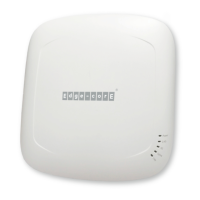User Manual
Enterprise Access Point
31
Antenna Mode: Select the number of spatial streams for the RF card – select 1T1R for one spatial
Select 1T1R for one spatial stream or 2T2R for two spatial streams.
Channel Width (available when Band is 802.11g+802.11n or 802.11a+802.11n or 802.11ac): Double
channel bandwidth to 40 MHz or 80 MHz to enhance throughput.
Channel: Select the appropriate channel from the drop-down menu to meet the regularity.
- When configured as “Auto” in Radio Card B, there is channel selector table for channel switching
when the chosen channel is interfered or DFS channel signal is detected
- For outdoor AP models, the “Outdoor mode” will affect the channel selection
Channel Selector: This option is displayed for RF card B when Band is set to 5GHz and Channel is
set to Auto or DFS channels. Select the desired channels for operation so that
- When the system boots up and Channel is set to Auto, the system would choose a channel from
the selected channels based on which channel is clearer.
- When the system decides that it will switch to another channel due to reasons such as when
radar signal is detected on a DFS channel, or when interference threshold (if set) is reached, it
will only switch to one of the selected channels based on which channel is clearer.
Transmit Power: The signal strength transmitted from the system can be selected by Levels.
- Each Level signifies a decrement of 1dBm from the highest power.
- Level 1 is the actual highest power, while Level 2 is the highest power minus 1dBm, so on and so
forth.
Distance: It refers to the distance from the system to the client or to another access point when
connected via WDS. After entering a value for distance, the value of ACK Timeout below will be auto-
adjusted.
ACK Timeout: It indicates a period of time when the system waits for an Acknowledgement frame sent
back from a station without retransmission. In other words, upon timeout, if the Acknowledgement
frame is still not received, the frames will be retransmitted. This option can be used to tune network
performance for extended coverage. For regular indoor deployments, please keep the default setting.
Beacon Interval (ms): The entered amount of time indicates how often the beacon signal will be sent
from the access point.
- The Beacon Interval must be greater than 500ms when more than 7 VAPs are enabled.
- The Beacon Interval must be greater than 250ms when more than 3 VAPs are enabled
Airtime Fairness: when 802.11a/b/g/n legacy devices occupy airtime, throughput for 802.11ac devices is
affected.
- Enable: to ensure all devices with different band compatibilities have the same air time. This
feature is ideal for networks with devices supporting different bands.
- Preferred Access: N band clients are prioritized. This feature is ideal for networks with devices
supporting different bands.
Packet Delay Threshold (ms): An Access Point may be occupied trying to transmit a packet to a busy
client or a client out of range, hence delaying transmission to other connected clients. When Enabled,
this Tx queue flushing mechanism drops packets and immediately begins to process others if the queue
has been processed for more than x milliseconds, where Default = 0 (disabled). This feature improves
the performance of complex wireless networks but may require some packets to be resent.

